-
Our new ticketing site is now live! Using either this or the original site (both powered by TrainSplit) helps support the running of the forum with every ticket purchase! Find out more and ask any questions/give us feedback in this thread!
You are using an out of date browser. It may not display this or other websites correctly.
You should upgrade or use an alternative browser.
You should upgrade or use an alternative browser.
Paris 2024 Olympics
- Thread starter Bald Rick
- Start date
- Status
- Not open for further replies.
Sponsor Post - registered members do not see these adverts; click here to register, or click here to log in
R
RailUK Forums
OuterDistant
Member
Mrs Distant has given up on it - we've got Gardeners' World on iPlayer.
1D53
Established Member
- Joined
- 2 Apr 2006
- Messages
- 2,737
Moments of excellence in the ceremony but it's mainly been pretty dull.
dangie
Established Member
I watched it until Great Britain went past. I’ll be honest it was a struggle to watch that long. At my age that will be useful time of my life I’ll never get back. It appeared to be a total mish-mash. I’m guessing it didn’t improve.Mrs Distant has given up on it - we've got Gardeners' World on iPlayer.
ABB125
Established Member
I wonder if the torch is going to Notre Dame? Depends on how much of a sense of humour the French have...
I was kind of expecting it to be going to the top of the Eiffel tower
I was kind of expecting it to be going to the top of the Eiffel tower
Lewisham2221
Established Member
It's still going...
Clearly, somebody had a big idea, which has not translated into reality very well. It's also very clearly been designed for television viewers, I'd be extremely disappointed if I were any of the people with tickets to attend in person...
Clearly, somebody had a big idea, which has not translated into reality very well. It's also very clearly been designed for television viewers, I'd be extremely disappointed if I were any of the people with tickets to attend in person...
dk1
Veteran Member
It’s
Totally agree. It really hasn’t transitioned very well at all. Just seemed to go on & on.
It's still going...
Clearly, somebody had a big idea, which has not translated into reality very well. It's also very clearly been designed for television viewers, I'd be extremely disappointed if I were any of the people with tickets to attend in person...
Totally agree. It really hasn’t transitioned very well at all. Just seemed to go on & on.
signed
Established Member
Mom got to go it, she left at 8pm because you couldn't see **** + the rainI'd be extremely disappointed if I were any of the people with tickets to attend in person...
brad465
Established Member
Britishness in a nutshell:
 x.com
x.com
x.com
You merely adopted the rain. I was born in it, molded by it
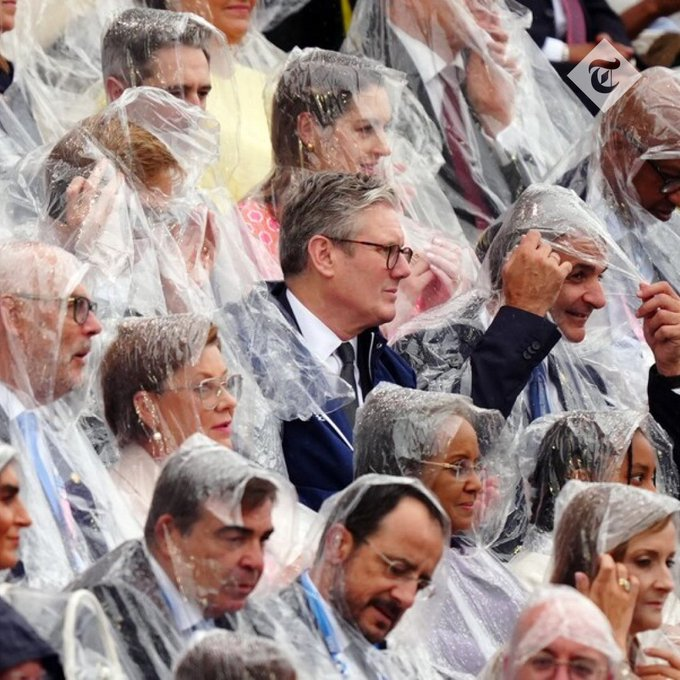
(Image of several officials watching the Olympic opening ceremony wearing ponchos, while the UK Prime Minister Sir Kier Starmer is not wearing one in the middle of the picture)
ABB125
Established Member
Interesting ceremony...
I think it was a nice idea in principle (especially the athletes travelling along the river), but it didn't work particularly well in practice. Especially for the people actually there, most of them will have been relying on the big screens along the river to see what was actually going on - as mentioned upthread, it was definitely designed with a television audience in mind. The weather probably didn't help.
From a broadcast point of view, I was quite impressed overall, especially as the event was unrehearsed - apart from I think two brief signal dropouts, there were no major/obvious technical issues. What I would have liked to see, though, was a better attempt at wiping the rain off the waterproof camera covers! For an event with this profile, having half the shot obscured by water droplets isn't really acceptable. Naturally you can't do a perfect job when it's raining that much, but to be perfectly honest the rain droplets made it look pretty amateurish.
My favourite bit (which will come as no surprise to anyone who knows me) was the light display on the Eiffel tower. I would love to be able to play with that sort of lighting! A somewhat unique canvas to turn into a brilliant display. This particular bit was enhanced by the rain, which acts like haze (if anything was better) and really accentuates the light beams.
[nerdy technical bit] I'm pretty confident the bright beam lights on the tower were laser-based, rather than LED, probably something like this: https://www.claypaky.it/products/skylos/, although they could have been less exciting discharge fixtures. I'll see if I can find out a bit more about the lighting used. They also seemed to have hired in the entire French stock of these https://www.chauvetprofessional.com/products/color-strike-m/ (or similar fixtures) for the path between the Louvre and the balloon/cauldron.
~~~
Anyway, I happened to have most of a day in Paris two weeks ago, at the end of an Interrail trip. I was only there because there were no Eurostar Interrail reservations available from Brussels (presumably due to the football?), and originally I was intending to spend the day on any loco-hauled trains I could find after a speed walk past a few of the main sights, like I normally do in new cities (because who would want to actually spend time looking round?! ). However, I very quickly discovered that they were in the middle of building the infrastructure for the opening ceremony, and since I spend far too much of my "spare" time doing theatre/events tech stuff, this was naturally very interesting. It was also a Sunday, so basically no loco-hauled trains around (except Intercites, which need a reservation...), so I decided to spend the day looking around the city instead (massive waste of the final day of my Interrail pass, but oh well!
). However, I very quickly discovered that they were in the middle of building the infrastructure for the opening ceremony, and since I spend far too much of my "spare" time doing theatre/events tech stuff, this was naturally very interesting. It was also a Sunday, so basically no loco-hauled trains around (except Intercites, which need a reservation...), so I decided to spend the day looking around the city instead (massive waste of the final day of my Interrail pass, but oh well!  ). Subsequently I discovered that it was not only Bastille Day (which would explain the military flypast I saw, although unfortunately I missed the parade, arriving on Avenue des Champs-Elysees shortly after it finished), but also the first day of the Olympic torch being carried round the city, so certainly one of the more interesting days to be walking around Paris!
). Subsequently I discovered that it was not only Bastille Day (which would explain the military flypast I saw, although unfortunately I missed the parade, arriving on Avenue des Champs-Elysees shortly after it finished), but also the first day of the Olympic torch being carried round the city, so certainly one of the more interesting days to be walking around Paris!
Here are some behind-the-scenes shots (in no particular order) of preparations for the opening ceremony and other temporary competition areas, focussing on the bits that I find interesting (like diesel generators and stacks of power distribution kit... ). Maybe someone else will find it interesting too... (incidentally, this seems to be a recurring theme for me, having previously supplied similar pictures for the Birmingham Commonwealth Games. I wonder what the next event I accidentally end up coming across will be?!)
). Maybe someone else will find it interesting too... (incidentally, this seems to be a recurring theme for me, having previously supplied similar pictures for the Birmingham Commonwealth Games. I wonder what the next event I accidentally end up coming across will be?!)
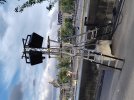
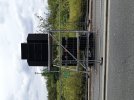
There were two main speaker stacks lining the river. The sort on the left was the most common, just 3 point source speakers suspended off a truss upright bolted to a concrete block. Nice and simple; I like the very advanced use of a plank of wood to make the block roughly level. Most of the river was lined with these. The type on the right was found much closer to the Eiffel tower, and is a much more interesting and advanced setup. First, there's a stack of line array pointing directly at the crowd, flanked by point source speakers at about 45degrees to provide more horizontal coverage. Below this is a line of 3 subwoofers, which appears to be set up for cardioid operation (ie: making the majority of the low frequency sound waves emanate towards the crowd/away from the river where it will benefit no-one. Lower frequencies are generally omni-directional (sort of, this is a bit simplistic but will do for now), so making them cardioid reduces volume where you don't want it to be, and increases it where you do. This is done by turning one of the subwoofers the "wrong" way and sending a slightly different signal to it, in order to cause controlled interference in the sound waves, to destructively interfere on the "quiet" side and constructively interfere on the "loud" side.) Below the scaffold tower is the amp rack for the stack, and this particular location has a power distro box to the let of the amp rack as well.
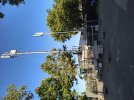
There were several temporary radio frequency masts along the river. I'm not sure if these were to allow the mobile networks to be able to cope with significantly increased traffic (some were branded with mobile network logos), or were for all the radio traffic required for the broadcast and technical aspects of the event (I would love to see the frequency allocation map for this!), but they certainly looked beefy.

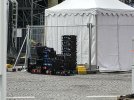
Temporary power outside the "stadium" that's been built at the Place de Concorde.

Video wall at the "stadium" built on the Esplanade des Invalides. This one is notable from my perspective, simply because I dread to think how much effort was required to get all those flight cases up to the top of the scaffold tower! This is at the top of the temporary stands, so probably getting on for 10m above the ground...
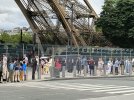

Some lighting now! Left picture is right next to the Eiffel tower (as is hopefully obvious... ). The rectangular fixtures to the left are for the colour wash across the tower (eg: "look, the Eiffel tower is blue!"), whilst the row of pointy moving heads centre and right are the "laser beams" that cut through the sky. Right picture is a view across the bridge to the Trocadero. Notably, I couldn't see the moving heads you can see on top of flightcases in use during the ceremony (and I was looking out for them as well!), all the light sources looked like they came from either side of the river, not the bridge (although that may just be the camera angles). Interestingly, the line array (speakers) above the stands seem to be at least two different types, although it's hard to tell from the picture: the hang at the far left of the truss looks to be "traditional" segment line array, whereas the two hangs further to the left look more like the new l'Accoustics (yes, it's a French company) L2 speakers. However, it must be said that stadium-size line array is definitely beyond the kit I normally use, so I could be very wrong!
). The rectangular fixtures to the left are for the colour wash across the tower (eg: "look, the Eiffel tower is blue!"), whilst the row of pointy moving heads centre and right are the "laser beams" that cut through the sky. Right picture is a view across the bridge to the Trocadero. Notably, I couldn't see the moving heads you can see on top of flightcases in use during the ceremony (and I was looking out for them as well!), all the light sources looked like they came from either side of the river, not the bridge (although that may just be the camera angles). Interestingly, the line array (speakers) above the stands seem to be at least two different types, although it's hard to tell from the picture: the hang at the far left of the truss looks to be "traditional" segment line array, whereas the two hangs further to the left look more like the new l'Accoustics (yes, it's a French company) L2 speakers. However, it must be said that stadium-size line array is definitely beyond the kit I normally use, so I could be very wrong! 

Here's some truss being attached to a building. I can't remember what particular building this is, but it shows the sort of thing they were doing to buildings along the river
That's it for the moment, hopefully at least one person has found this mildly interesting! . I have quite a few more picture if anyone is interested, but mainly they're of things like a crate of chunky power cable, or the connectors on the radio towers...
. I have quite a few more picture if anyone is interested, but mainly they're of things like a crate of chunky power cable, or the connectors on the radio towers...
I think it was a nice idea in principle (especially the athletes travelling along the river), but it didn't work particularly well in practice. Especially for the people actually there, most of them will have been relying on the big screens along the river to see what was actually going on - as mentioned upthread, it was definitely designed with a television audience in mind. The weather probably didn't help.
From a broadcast point of view, I was quite impressed overall, especially as the event was unrehearsed - apart from I think two brief signal dropouts, there were no major/obvious technical issues. What I would have liked to see, though, was a better attempt at wiping the rain off the waterproof camera covers! For an event with this profile, having half the shot obscured by water droplets isn't really acceptable. Naturally you can't do a perfect job when it's raining that much, but to be perfectly honest the rain droplets made it look pretty amateurish.
My favourite bit (which will come as no surprise to anyone who knows me) was the light display on the Eiffel tower. I would love to be able to play with that sort of lighting! A somewhat unique canvas to turn into a brilliant display. This particular bit was enhanced by the rain, which acts like haze (if anything was better) and really accentuates the light beams.
[nerdy technical bit] I'm pretty confident the bright beam lights on the tower were laser-based, rather than LED, probably something like this: https://www.claypaky.it/products/skylos/, although they could have been less exciting discharge fixtures. I'll see if I can find out a bit more about the lighting used. They also seemed to have hired in the entire French stock of these https://www.chauvetprofessional.com/products/color-strike-m/ (or similar fixtures) for the path between the Louvre and the balloon/cauldron.
~~~
Anyway, I happened to have most of a day in Paris two weeks ago, at the end of an Interrail trip. I was only there because there were no Eurostar Interrail reservations available from Brussels (presumably due to the football?), and originally I was intending to spend the day on any loco-hauled trains I could find after a speed walk past a few of the main sights, like I normally do in new cities (because who would want to actually spend time looking round?!
Here are some behind-the-scenes shots (in no particular order) of preparations for the opening ceremony and other temporary competition areas, focussing on the bits that I find interesting (like diesel generators and stacks of power distribution kit...


There were two main speaker stacks lining the river. The sort on the left was the most common, just 3 point source speakers suspended off a truss upright bolted to a concrete block. Nice and simple; I like the very advanced use of a plank of wood to make the block roughly level. Most of the river was lined with these. The type on the right was found much closer to the Eiffel tower, and is a much more interesting and advanced setup. First, there's a stack of line array pointing directly at the crowd, flanked by point source speakers at about 45degrees to provide more horizontal coverage. Below this is a line of 3 subwoofers, which appears to be set up for cardioid operation (ie: making the majority of the low frequency sound waves emanate towards the crowd/away from the river where it will benefit no-one. Lower frequencies are generally omni-directional (sort of, this is a bit simplistic but will do for now), so making them cardioid reduces volume where you don't want it to be, and increases it where you do. This is done by turning one of the subwoofers the "wrong" way and sending a slightly different signal to it, in order to cause controlled interference in the sound waves, to destructively interfere on the "quiet" side and constructively interfere on the "loud" side.) Below the scaffold tower is the amp rack for the stack, and this particular location has a power distro box to the let of the amp rack as well.

There were several temporary radio frequency masts along the river. I'm not sure if these were to allow the mobile networks to be able to cope with significantly increased traffic (some were branded with mobile network logos), or were for all the radio traffic required for the broadcast and technical aspects of the event (I would love to see the frequency allocation map for this!), but they certainly looked beefy.


Temporary power outside the "stadium" that's been built at the Place de Concorde.

Video wall at the "stadium" built on the Esplanade des Invalides. This one is notable from my perspective, simply because I dread to think how much effort was required to get all those flight cases up to the top of the scaffold tower! This is at the top of the temporary stands, so probably getting on for 10m above the ground...


Some lighting now! Left picture is right next to the Eiffel tower (as is hopefully obvious...

Here's some truss being attached to a building. I can't remember what particular building this is, but it shows the sort of thing they were doing to buildings along the river
That's it for the moment, hopefully at least one person has found this mildly interesting!
Hornet
Member
- Joined
- 16 Jul 2013
- Messages
- 741
Never knew Celine Dion and Lady Gaga were French (Sarcasm!!). Watched some of it in the pub with the other half. It was terrible, especially the Catwalk crap. We spent most of the evening trying, and failing to name anyone of the French 'stars' and torch holders. Would have been impressed if Antoine Dupont had lit the Montgolfier Brothers balloon, but c'est la vie!
GRALISTAIR
Established Member
I am going to try to not watch a single minute of the entire games.
brad465
Established Member
Whenever there's an opening ceremony parade, I remember that Ireland essentially has to act as a UN Buffer Zone, as the alphabetical order of countries goes: "Iran, Iraq, Ireland, Israel".

You could watch the 100m and 200m finals together and still not watch a single minute of the gamesI am going to try to not watch a single minute of the entire games.
GRALISTAIR
Established Member
of course I had not realized that!Whenever there's an opening ceremony parade, I remember that Ireland essentially has to act as a UN Buffer Zone, as the alphabetical order of countries goes: "Iran, Iraq, Ireland, Israel".
Very true lol!You could watch the 100m and 200m finals together and still not watch a single minute of the games
dangie
Established Member
Or to really get your two pence worth, both men’s & women’s 100m, the men’s 110m hurdles, plus the women’s 100m hurdles. I’m sure if you delve into other sports as well you could probably get even more value for moneyYou could watch the 100m and 200m finals together and still not watch a single minute of the games

Brilliant!!!!
I agree, that was brilliantBrilliant!!!!
You've got to feel for the Feench:
- First their transport system is sabotaged on the day of the opening ceremony
- It pours with rain throughout the ceremony
- The ceremony itself sounded as though it would be great, the reality was somewhat different
On the other hand, the neighbours in London absolutely nailed it in 2012
- First their transport system is sabotaged on the day of the opening ceremony
- It pours with rain throughout the ceremony
- The ceremony itself sounded as though it would be great, the reality was somewhat different
On the other hand, the neighbours in London absolutely nailed it in 2012
dk1
Veteran Member
You've got to feel for the Feench:
- First their transport system is sabotaged on the day of the opening ceremony
- It pours with rain throughout the ceremony
- The ceremony itself sounded as though it would be great, the reality was somewhat different
On the other hand, the neighbours in London absolutely nailed it in 2012
Absolutely
There were lots of drop outs throughout the procession, and several of them I wouldn't exactly describe as brief! But compared to the wider technical and creative issues with the event, they pale into insignificance.From a broadcast point of view, I was quite impressed overall, especially as the event was unrehearsed - apart from I think two brief signal dropouts, there were no major/obvious technical issues.
Overall, everyone involved should be mighty proud of what they achieved, even if that was a complete mess. It was an ambitious event from the start, and all the concerns about how to technically achieve it as well as how it could ever flow together as a seamless event were clearly realised. The lack of proper rehearsal then put the nails in the coffin of the production.
Throughout the event there was badly cut cameras, cameras pointing at the wrong things, shots badly framed, set elements getting in the way, hardly anything was racked properly, especially compared to anything else, the audio seemed out of time to what the performers were hearing, it was impossible to tell what was mimed and what wasn't, and all the pre-recorded stuff stood out like a sore thumb because it was shot completely differently and in glorious sunshine.
Then on the creative side it was just as much of a mess. The can can performance was one of the worst I've ever seen - it looked like they couldn't hear the music. They had people doing elaborate routines, but we'd cut away from that to look at someone else doing something completely unrelated. Much of it looked like nobody really knew how long it was going to take - like the horse coming up the river - looked amazing, but did we really need 5 minutes off it uninterrupted?
Like I said, kudos to everyone involved, they will have worked their behinds off to try and make this work. But the idea was flawed at the start and didn't have a strong enough leader to come up with something that worked as a single piece. Many people have said the last 15 minutes was the best - and it was - it felt to be like that was the only bit they had a clear idea on what was happening and what it was going to look like.
You can only wipe your lens down so much. If you've run out of dry cloth, it's game over, all you're going to do is move the water about. Couple that with multiple times where there was either only one available camera or the cameras were not in a position to be cleaned easily, and you're going to get water in every shot.What I would have liked to see, though, was a better attempt at wiping the rain off the waterproof camera covers! For an event with this profile, having half the shot obscured by water droplets isn't really acceptable.
(Image of several officials watching the Olympic opening ceremony wearing ponchos, while the UK Prime Minister Sir Kier Starmer is not wearing one in the middle of the picture)
There is no such thing as bad weather, only the wrong clothes.
Never knew Celine Dion and Lady Gaga were French (Sarcasm!!).
Re. Dion, some French-canadians are more french that those born in France.
And Lady Gaga herself has a bit of French-Canadian ancestry.Re. Dion, some French-canadians are more french that those born in France.
In that case, I'm surprised they didn't snatch up Madonna for the gig!
Me likewise, being a confirmed sport-hater. "I'm so ignorant that I think 'Olympics' is what a hard-to-please film critic says about a bunch of cinematic offerings which don't float his boat -- 'oh, limp pics'I am going to try to not watch a single minute of the entire games.
dangie
Established Member
Where was Plastic Bertrand…??In that case, I'm surprised they didn't snatch up Madonna for the gig!
Note: Just Googled him. He was Belgian. For all these years I thought he was French. Oh well, you live and learn. Every day’s a school day

Snow1964
Established Member
First medal (apparently first time on day 1 for 20 years), for GB
bronze in 3m synchronised diving, after one of the Australians nearly missed board and dropped from 3rd to 5th on final dive.
bronze in 3m synchronised diving, after one of the Australians nearly missed board and dropped from 3rd to 5th on final dive.
philosopher
Established Member
- Joined
- 23 Sep 2015
- Messages
- 1,443
Unless the city hosting has very reliably dry summer weather, you are taking quite a big gamble by having an opening ceremony that is not undercover. Unfortunately for Paris the bet did not pay off!- First their transport system is sabotaged on the day of the opening ceremony
- It pours with rain throughout the ceremony
- The ceremony itself sounded as though it would be great, the reality was somewhat different
On the other hand, the neighbours in London absolutely nailed it in 2012
Me too! Though the BBC already seems to be doing its best to force the stuff down our throats, whether we will or not. And all this coming on top of the utter tedium of football and Wimbledon ....I am going to try to not watch a single minute of the entire games.
- Status
- Not open for further replies.
